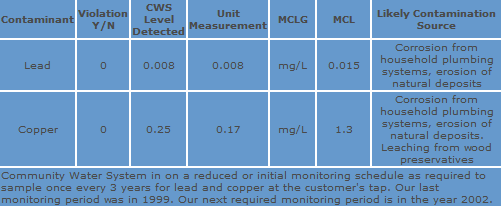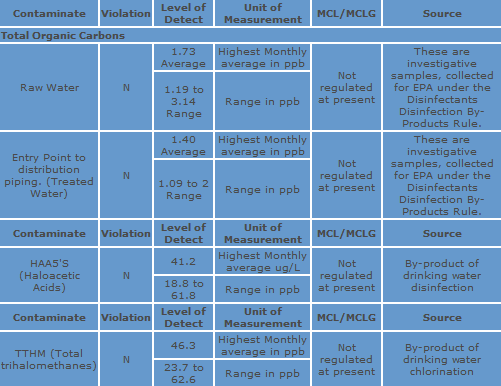These reports are part of stricter regulations passed down from the federal level. Each water utility is required to gather this information and report these findings to the Department of Health. Failure to abide by these regulations can result in heavy fines.
2001 The Water We Drink
Community Water System / Greers Ferry Lake
We are pleased to present to you the 2001 Annual Water Quality Report, "The Water We Drink." This report is designed to inform you about the quality of water and services we deliver to you every day. Our constant goal is to provide you with a safe, dependable supply of drinking water. We want you to understand the efforts we make to continually improve the water treatment process and protect our water resources. We are committed to ensuring the quality of your water.
The sources of drinking water (both tap water and bottled water) include rivers, lakes, streams, ponds, reservoirs, springs and wells. As water travels over the surface of the land or through the ground, it dissolves naturally occurring minerals and, in some cases, can pick up substances resulting from the presence of animals or from human activity. Our water source is Greers Ferry Lake; a U.S. Army Corps of Engineers constructed lake, whose water shed is from the North Fork, Middle Fork and South Fork of the Little Red River. It is an excellent and bountiful surface water resource.
Community Water System has a source water protection plan available at our office that provides more information, such as potential sources of contamination. This plan is available to the public during normal business hours. Please call our office in advance to review our source water assessment plan. If you have any questions about this report or your water utility, please contact Greg Smith, General Manager, at (501) 825-7294 or (800) 234-2971. We value you as a customer and want to keep you informed about your water company. Community Water System has monthly board meetings on the third Monday of each month, starting at 6:00 p.m. at the Community Water System office at 299 Lakeshore Drive, Greers Ferry, Arkansas. The annual meeting is held on the third Monday in April of each year, with the monthly board meeting the following day at its regularly scheduled time of 6:00 p.m. The notice of the annual meeting is mailed to you each year, indicating the location and time of the meeting.
Contaminates that may be present in source water include: Microbiological Contaminants such as bacteria, which may come from sewage treatment plants, septic systems, agricultural livestock operations and wildlife. Inorganic Contaminates such as salts and metals which can be naturally-occuring or result from urban storm water runoff, industrial or domestic wastewater discharges, oil and gas production, mining or farming and pesticides and herbicides which may come from a variety of sources such as agriculture, urban storm water runoff and residential uses. Organic Chemical Contaminates including synthetic and volatile organic chemicals, which are byproducts of industrial processes and petroleum production can also come from gas stations, urban storm water runoff and septic systems. Radioactive Contaminates can be naturally occurring or be the result of oil and gas production and mining activities.
Community Water System continually monitors for constituents in your drinking water according to Federal and State laws. The Water Monitoring Charts that follow show the results of our monitoring for the period of January 1 to December 31, 2001. All drinking water, including bottled drinking water, may be reasonably expected to contain at least small amounts of some constituents. It is important to remember that the presence of these constituents does not necessarily pose a health risk.
While not required under EPA regulations, CWS monitors for cryptosporidium. We have not detected cryptosporidium in the finished water or source water in 12 out of 12 samples tested. We believe it is important for you to know that some people may be more vulnerable to contaminants in drinking water than the general population. Immuno-compromised persons such as persons with cancer undergoing chemotherapy, persons who have undergone organ transplants, people with HIV/AIDS or other immune system disorders, some elderly and infants can be particularly at risk from infections. These people should seek advice about drinking water from their health care providers. EPA/CDC guidelines on appropriate means to lessen the risk of infection by cryptosporidium and other microbiological contaminants are available from the Safe Drinking Water Hotline (800) 426-4791.
In our continuing efforts to maintain a safe and dependable water supply, it may be necessary to make improvements in your water system. The costs of these improvements may be reflected in the rate structure. Rate adjustments may be necessary in order to address these improvements. For CY'2002, no retail rate changes are proposed.
For CY'2002, the wholesale water rate will increase from $2.18 per thousand gallons to $2.232 per thousand gallons. This is the cost per thousand gallons paid to Community Water System by its wholesale customers for water delivered through the Faulkner/Cleburne County transmission line going south from Greers Ferry Lake. The communities receiving water from CWS are the cities of Quitman, Guy, Greenbrier, Wooster and Mayflower and the Beaverfork and Vilonia water Associations.
CWS is happy to announce that the backup generating equipment installed in 1999 for all treatment, critical pumping and master meter facilities throughout the entire retail and wholesale systems is in good working order. This equipment ensures CWS that it has the ability to meet the water delivery needs of all our customers in the event of a loss of electrical power because of lightning events or natural disasters. CWS continues to utilize your revenue resources to upgrade the treatment and delivery system.
Community Water System has 28 trained employees, (15 of which are licensed by the State of Arkansas), and 5 board members who stand ready to meet your water supply needs around the clock. Thank you for allowing us to continue providing your family with clean, quality water this year. Thank you for understanding. We at Community Water System work around the clock to provide top quality water to every tap. To make sure safe water is always available, we ask all of our customers to help us protect our water sources. Our people and our communities depend on safe water. It is a major ingredient in our lives and our children's lives…now, and in the future.
Test Results
Microbiological Contaminants (Porentially harmful microorganisms that may be occuring or introduced by humans.)

Clarity (The amount of suspended solids in water, when in access, can impede the chlorine disinfection process.) Turbidity is the measure of water cloudiness. We monitor it becaus eit is a good indicator of the effectiveness of our filtration system.

Inorganic Contaminents (Chemicals primarily introduced from groundwater through natural geologic formations or by human activity.)

Volitile Organic Contaminents (Contaminents such as pesticides produced from agricultural and industrial activities)

Lead and Copper Tap Monitoring

Total Organic Compounds - Investigative Testing Results (Derived primarily from decaying organic matter in runoff)

Unregulated Contaminants

To better understand the Water Monitoring Tables, listed below are abbreviations and definitions:
Non-Detects (ND)…Laboratory analysis indicates that the constituent is not present.
Parts per million (ppm) or Milligrams per liter (mg/L)…One part per million corresponds to one minute in two years or one penny in $10,000.
Parts per billion (ppb) or Micrograms per liter (ug/L)… One part per billion corresponds to one minute in 2,000 years, or one penny in $10,000,000.
Nephelometric Turbidity Unit (NTU)…Measures the clarity of water. Turbidity in excess of 5 NTU is just noticeable to the average person.
Action Level…The concentration of a contaminant, which if exceeded, triggers treatment or other requirements a water system must follow.
Treatment Technique (TT)…A required process intended to reduce the contaminant level in drinking water.
Maximum Contaminant Level (MCL)…The highest contaminant level allowed in drinking water. MCLs are set as close to the MCLGs as feasible using the best available treatment technology.
Maximum Contaminant Level Goal (MCLG)…A contaminant level in drinking water below which there is no known or expected risk to health. MCLGs allow for a margin of safety.
Maximum Elevation Served (MSL)Million Gallons per Day (mgd)
MCLs are set at very stringent levels. To understand the possible health effects described for many regulated constituents, a person would have to drink 2 liters of water every day at the MCL level for a lifetime to have a one-in-a-million chance of having the described health effect.
